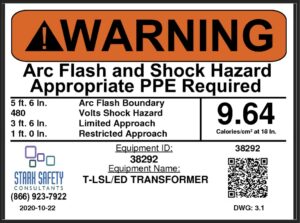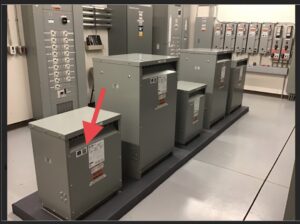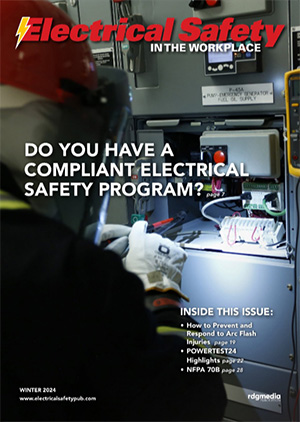Using Technology to Enhance Electrical Safety
By Steven J Abbott, REALTIME-SAFETY.com

While there is a lot of important and useful information on the arc flash warning label, the concern is how quickly that new arc flash label no longer accurately represents the hazards that exist at the present time.
There is a growing overemphasis in the job planning process to simply use the information on an applied arc flash warning sticker. This all too often creates an unconscious disregard or forgetfulness to review other critical sources of information that are important to the electrical safety planning process and creates an incomplete picture of the hazard and associated risk. We will take a look at how this can increase the risk of an arc flash or shock-related injury.
First let’s be clear: there is a lot of important and useful information on the arc flash warning label (based on the 2021 NFPA 70E 130.5(H) Equipment Labeling). The immediate concern is how quickly that new arc flash label no longer accurately represents the hazards that exist at the present time. Changes occur very quickly and very often in some work environments, which make it easy to have incorrect information being used for safety.
Here is a breakdown some of the additional information that you typically will not find on an arc flash warning label that should at least be reviewed in the job planning process:
Current system details: One-line diagrams, detailed arc flash analysis reports (which may include specific analysis assumptions, more specific system switching configurations that may need to be determined before proceeding), as well as any equipment specifications, cut sheets, or manufacturers’ documentation.
Equipment Historical data: Inspection data, logs/reports of preventive maintenance actions, and any repairs to fix problems that may have occurred (or, just as important are the repairs that have been identified but not yet fixed).
Other Concerns: At some point most workers will realize that the arc flash analysis information (labels, drawings, etc.) is no longer accurately providing the information needed to plan and prepare for the task at hand. When that point is reached, far too many qualified and knowledgeable individuals will no longer rely on the warning label and try to come up with their own best on-the-spot assessment to do the job as safely with the incomplete information at their disposal.

Using only the warning label applied to a piece of equipment is only providing you limited information and potentially outdated information.
A quick remedy to this practice can simply be to quickly communicate the changes that have occurred or the problems that have been addressed by using available technology to document or “alert” anybody and everybody who would potentially have access to that equipment to ensure that they are made aware. With most workers having a smartphone, quick alerts using text or email can really keep the changes in the forefront for everyone to notice of and prevent an accident for failure of being aware.
Considering that in 2021 much of the workforce would rather use a touchscreen than a pencil and paper, it creates a much more inviting situation for workers to be able to participate and use information in a readily available format, and it makes it simpler if all records and information for a specific device is compiled in one easy-to-access source. This cuts out countless hours of not only compiling and sharing documents, but also clearing out outdated information. What this does is create for industry that our social culture has become accustomed to, which is getting information as close to when it happens as possible or having it in “realtime”. The alternative could be gaps in time when new information has been shared, which adds a layer of risk to the job planning process.
Imagine being able to access the current one-line diagrams via your mobile device and quickly get the newest versions as soon as they are available or having pictures instantly shared (or even videos) to illustrate and explain things that are found to have changed from previous installations / conditions.
Imagine being able to access schematics or manufactured cut sheets and quickly view any prior preventative maintenance efforts or even documented inspection findings to quickly be able to evaluate the current equipment as to if any of those findings still exist or if they have been abated.
Using only the warning label applied to a piece of equipment is only providing you limited information and potentially outdated information unless you pursue and review other related sources of information that can confirm its accuracy or to determine if a more up-to-date accurate piece of information is available. Using technology to keep your information readily available to the workers who need it can make their jobs: QUICKER, SIMPLER, SAFER. ESW
Steven J Abbott is owner of Stark Safety Consultants and REALTIME-SAFETY.com, an online cloud-based system that offers a quicker, simpler and safer solution to data collection, device document and system change tracking, and preventative maintenance and more… (WWW.REALTIME-SAFETY.com).
Share on Socials!
Changes to NFPA 70E® 2021 for Electrical Safety in the Workplace®
Electrical Safety Finds Its North Star
Do You Have a Compliant Electrical Safety Program?
Leaders in Electrical Safety
• Aramark
• Bowtie Engineering
• Enespro
• Ericson
• I-Gard Corporation
• IRISS
• KERMEL, INC.
• Lakeland Industries
• MELTRIC Corporation
• National Safety Apparel
• National Technology Transfer
• Oberon
• Saf-T-Gard
• SEAM Group
Subscribe!
Sign up to receive our industry publications for FREE!







